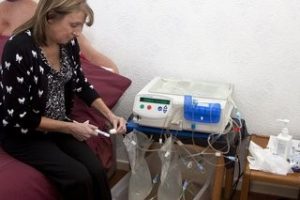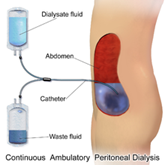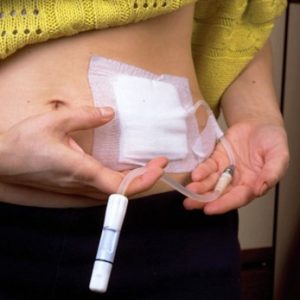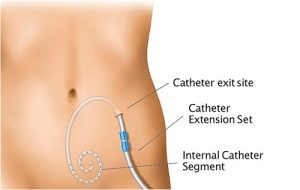What is peritoneal dialysis (PD)?
Keep track of your kidney data with PKB
Key Points
- Peritoneal dialysis (PD) is done at home
- There are two types: APD (machine based at night) and CAPD (manual, 4 times through the day)
- Both need to be done every day
- The main complication is an infection of the tummy called peritonitis, which is easy to treat
- You can stay on PD indefinitely.
So. What is peritoneal dialysis (PD)? Let’s start with the basics.
1. What is dialysis?
Dialysis is a treatment to remove waste products and fluid from your blood. It is needed when chronic kidney disease (CKD) has progressed to a point when your own kidneys can no longer do this. This is called CKD Stage 5, i.e. kidney failure.
Dialysis is one (albeit very important) aspect of your care, but it is only part of your total treatment. There are tablets and injections (like erythropoietin, EPO) that are very important as well.
2. What the two main types of dialysis?
Peritoneal dialysis and haemodialysis are the two main types. Both types provide about 5% kidney function. In this way, they do not ‘cure’ kidney failure, just control it – by replacing some of your kidney function. Most patients start to feel a bit better three months or more after starting dialysis.
When kidneys reach CKD5, they rarely recover. Dialysis is usually permanent (or until you have a transplant).
3. What are the basics of peritoneal dialysis?
This occurs either at night with the assistance of a machine, known as automated peritoneal dialysis (APD); or at regular intervals throughout the day, known as continuous ambulatory peritoneal dialysis (CAPD).
Both types of peritoneal dialysis take place at home.
Most patients will also be asked to follow a fluid restriction of 2 litres a day, or less. This can be hard but not as hard as haemodialysis, where the fluid restriction is 1.5 litres a day.
4. How does PD work?
In both types of PD, tiny blood vessels inside the abdominal lining (peritoneum) filter blood through the aid of a cleansing dialysis liquid. This liquid is a type of cleansing glucose (sugar) fluid, with water, salt and other additives.
Using a chemical method (called diffusion), the solution ‘pulls’ toxins and extra water from the blood into it. When you discard the used PD fluid it gets rid of the toxins and extra water.
5. What is automated peritoneal dialysis (APD)
Many people prefer to do peritoneal dialysis at night. With automated peritoneal dialysis, a machine called a ‘cycler’ pumps dialysis fluid in and out of the body while you sleep. It is done every night, and takes 8 to 10 hours, with 10-12 litres drained in and out of your abdomen.
You can live your normal life in the day time, when you are not on the APD machine.

Automated peritoneal dialysis (APD) machine
6. What is continuous ambulatory peritoneal dialysis (CAPD)?
This is done manually by the patient, usually four times a day. In most patients, a 2 litre bag of dialysis solution (liquid) is drained in by the patient, and left there for about four hours (10-12 for the night bag).
After four (10-12 for night bag) hours, it is drained out with waste products and water in it. And another 2 litres of fresh solution are put in. The exchange takes about 25 minutes. You sleep with the solution in your stomach all night.
CAPD means ‘continuous’ and ‘ambulatory’ (when you walk about, and machine-free) ‘peritoneal dialysis’. It works while you go about your normal activities such as work or school.

7. What happens before you start peritoneal dialysis?
About two weeks before you start peritoneal dialysis, you will have a minor surgical operation. A doctor inserts a soft, thin tube (catheter) through your tummy and into the peritoneum. This is done either when you are asleep (general anaesthetic) or awake (local anaesthetic, i.e. painkiller injected).
After two weeks you attend the hospital daily for 2-3 days to be trained to do the dialysis yourself. This catheter stays in place permanently.


Half the catheter is inside the body and is a spiral shape
8. Is peritoneal dialysis painful?
No. The liquid in your tummy can make you feel bloated or full. It might feel uncomfortable, but the treatment isn’t painful. Your stomach may stick out more than usual when it’s filled with fluid.
A small proportion of people can experience drainage pain, this is where the catheter pulls on nerves inside your abdomen. The pain normally settles after a few weeks.
9. What are the complications of PD?
The commonest complication is a short-term bacterial infection of the lining of the abdomen called (bacterial) peritonitis. A longer term form for peritonitis infection can also be caused by tuberculosis.
There can also be infections of the catheter exit site and tunnel. All can be treated by antibiotics and other drugs. If that does not work, the catheter has to be removed.
Non-infectious complications include problems with drainage of the catheter, dialysis fluid leakage, hernias, and a rare problem called sclerosing peritonitis (scarring of the peritoneum).
In order for PD to work gentle laxatives must be taken on a daily basis, if patients become constipated the tube can move on the inside, this can cause poor drainage of the fluid.
10. What are advantages of peritoneal dialysis (and haemodialysis)?
Peritoneal dialysis
- Independence
- Travelling easier (none)
- Can drink more
- As continuous, more like normal kidneys.
Haemodialysis
- Less work for you
- Easier to increase dialysis dose
- Company of other patients
- Easier to get nurses and doctors to see you.
Summary
We have described what is peritoneal dialysis (PD). We hope it has been helpful.
Top Tip
If you need dialysis it is often a good idea to start with peritoneal dialysis, to preserve your veins for later in life, as you may need them for haemodialysis. It is also good as a short-term bridge to a transplant.
Other resources
What is a peritoneal dialysis (PD) catheter?
This article was reviewed by Connor Price, Peritoneal Dialysis Nurse, UHCW Coventry
This is another video, just about PD: https://www.pdempowers.com/peritoneal-dialysis-pd-home-video.
Last Reviewed on 15 May 2024
